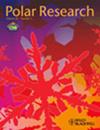斯瓦尔巴群岛沿岸雌北极熊空间利用的稳定性:个体内变异和亲缘关系的影响
IF 1.3
4区 地球科学
Q3 ECOLOGY
引用次数: 3
摘要
病理学影响动物的分布,并可能导致基于亲缘关系的空间结构,在这种结构中,接近性和关联性紧密相连。在巴伦支海地区,海岸生态型的北极熊(Ursus maritimus)全年都生活在斯瓦尔巴群岛内。这种沿海战略被认为是多年来稳定的;然而,人们对场地保真度的个体内变异性或亲属关系对空间利用的影响知之甚少。使用高分辨率GPS遥测技术,我们观察了17只沿海雌性北极熊在八年(2011-19年)内的多年文献记录,并调查了这是否与雌性北极熊的亲缘程度有关。个体在连续和非连续年份都表现出稳定的空间使用。每年的个体家园范围(HR)平均重叠44%(范围:9-96%),它们的质心平均相距15公里(范围:2-63公里)。相关雌性的空间使用揭示了全年强大的雌性亲属结构。相关雌性的年HR平均重叠24%(范围:0-66%),它们的质心平均相距18公里(范围:2-52公里)。相反,非亲缘关系的雌性质心之间的距离要大得多(平均:160公里,范围:59–283公里)。此外,雌性在所有季节都表现出很好的位点保真度:单个季节性HR质心平均相距不到30公里(范围:1.8-172公里)。该地区的熊似乎比其他地区的熊表现出更强的场地保真度。这些发现还强调了母亲学习在空间利用中的重要性。本文章由计算机程序翻译,如有差异,请以英文原文为准。
Stability of space use in Svalbard coastal female polar bears: intra-individual variability and influence of kinship
Philopatry influences animal distribution and can lead to a kinship-based spatial structure, where proximity and relatedness are tightly linked. In the Barents Sea region, polar bears (Ursus maritimus) of the coastal ecotype remain year-round within the Svalbard archipelago. This coastal strategy is thought to be stable across years; however, little is known about the intra-individual variability in site fidelity or the influence of kinship on space use. Using high-resolution GPS telemetry, we looked at multi-year philopatry among 17 coastal female polar bears over eight years (2011–19) and investigated whether it is linked to the females’ degree of kinship. Individuals showed a stable space use in both consecutive and non-consecutive years. Yearly individual home ranges (HRs) overlapped, on average, by 44% (range: 9–96%), and their centroids were, on average, 15 km (range: 2–63 km) apart. The space use of related females revealed a year-round strong female kin structure. Annual HRs of related females overlapped, on average, by 24% (range: 0–66%), and their centroids were, on average, 18 km (range: 2–52 km) apart. In contrast, non-related females had much larger distances between centroids (average: 160 km, range: 59–283 km). Additionally, females showed a great site fidelity in all seasons: individual seasonal HR centroids were, on average, less than 30 km (range: 1.8–172 km) apart. Bears in this region seem to exhibit a stronger site fidelity than those reported from other parts of the species range. These findings also highlight the importance of maternal learning in space use.
求助全文
通过发布文献求助,成功后即可免费获取论文全文。
去求助
来源期刊

Polar Research
地学-地球科学综合
CiteScore
3.20
自引率
5.30%
发文量
22
审稿时长
>12 weeks
期刊介绍:
Since 1982, Polar Research has been the international, peer-reviewed journal of the Norwegian Polar Institute, Norway''s central institution for research, environmental monitoring and mapping of the polar regions. Aiming to promote the exchange of scientific knowledge about the Arctic and Antarctic across disciplinary boundaries, Polar Research serves an international community of researchers and managers. As an open-access journal, Polar Research makes its contents freely available to the general public.
Original primary research papers comprise the mainstay of Polar Research. Review articles, brief research notes, letters to the editor and book reviews are also included. Special issues are published from time to time.
The scope of Polar Research encompasses research in all scientific disciplines relevant to the polar regions. These include, but are not limited to, the subfields of biology, ecology, geology, oceanography, glaciology and atmospheric science. Submissions from the social sciences and those focusing on polar management and policy issues are welcome. Contributions about Antarctica are particularly encouraged.
 求助内容:
求助内容: 应助结果提醒方式:
应助结果提醒方式:


